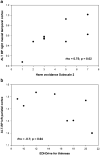Altered 5-HT(2A) receptor binding after recovery from bulimia-type anorexia nervosa: relationships to harm avoidance and drive for thinness
- PMID: 15054474
- PMCID: PMC4301578
- DOI: 10.1038/sj.npp.1300430
Altered 5-HT(2A) receptor binding after recovery from bulimia-type anorexia nervosa: relationships to harm avoidance and drive for thinness
Abstract
Several lines of evidence suggest that a disturbance of serotonin neuronal pathways may contribute to the pathogenesis of anorexia nervosa (AN) and bulimia nervosa (BN). This study applied positron emission tomography (PET) to investigate the brain serotonin 2A (5-HT(2A)) receptor, which could contribute to disturbances of appetite and behavior in AN and BN. To avoid the confounding effects of malnutrition, we studied 10 women recovered from bulimia-type AN (REC AN-BN, > 1 year normal weight, regular menstrual cycles, no binging, or purging) compared with 16 healthy control women (CW) using PET imaging and a specific 5-HT(2A) receptor antagonist, [18F]altanserin. REC AN-BN women had significantly reduced [18F]altanserin binding potential relative to CW in the left subgenual cingulate, the left parietal cortex, and the right occipital cortex. [18F]altanserin binding potential was positively related to harm avoidance and negatively related to novelty seeking in cingulate and temporal regions only in REC AN-BN subjects. In addition, REC AN-BN had negative relationships between [18F]altanserin binding potential and drive for thinness in several cortical regions. In conclusion, this study extends research suggesting that altered 5-HT neuronal system activity persists after recovery from bulimia-type AN, particularly in subgenual cingulate regions. Altered 5-HT neurotransmission after recovery also supports the possibility that this may be a trait-related disturbance that contributes to the pathophysiology of eating disorders. It is possible that subgenual cingulate findings are not specific for AN-BN, but may be related to the high incidence of lifetime major depressive disorder diagnosis in these subjects.
Copyright 2004 Nature Publishing Group
Figures


References
-
- American Psychiatric Association . Diagnostic and Statistical Manual of Mental Disorders. American Psychiatric Association; Washington DC: 1994.
-
- Arango V, Underwood MD, Mann JJ. Postmortem findings in suicide victims. Implications for in vivo imaging studies. Ann NY Acad Sci. 1997;836:269–287. - PubMed
-
- Artmann H, Grau H, Adelmann M, Schleiffer R. Reversible and non-reversible enlargement of cerebrospinal fluid spaces in anorexia nervosa. Neuroradiology. 1985;27:304–312. - PubMed
-
- Attar-Levy D, Martinot JL, Blin J, Dao-Castellana MH, Crouzel C, Mazoyer B, et al. The cortical serotonin2 receptors studied with positron-emission tomography and [18F]-setoperone during depressive illness and antidepressant treatment with clomipramine. Biol Psychiatry. 1999;45:180–186. - PubMed
-
- Audenaert K, Van Laere K, Dumont F, Vervaet M, Goethals I, Slegers G, et al. Decreased 5-HT2a receptor binding in patients with anorexia nervosa. J Nucl Med. 2003;44:163–169. - PubMed
Publication types
MeSH terms
Substances
Grants and funding
LinkOut - more resources
Full Text Sources

